Episode 214
What you’ll learn in this episode:
- What triggered Gabi’s obsession with spoons
- Why the most elementary shapes are the perfect canvas for exploration
- How Gabi uses wax to create her pieces
- Why Gabi never polishes the spoons she creates, and why there is beauty in imperfection
- Why there is no time limit to study and make jewelry
About Gabi Veit
Gabi Veit is an Italian artist and jewelry designer with a passion for spoons. She lives and works in Bozen/Südtirol/Italia and in Aesch/Zürich/Switzerland. Having grown up in South Tyrol, she creates jewelry that celebrates the rough and jagged shapes and outlines of her home country’s rocks and mountains. Her unique spoons surprise the beholder with unusual shapes borrowed from plant life.
Additional Resources:
Photos:
“Rosengarten” photo by ©Federico Cavicchioli
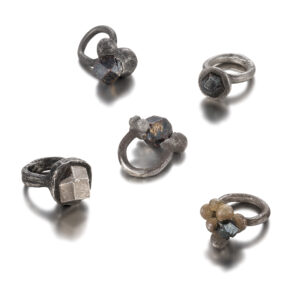
“Deadlysins” ©grassi museum fuer angewandte kunst Photo by: Christoph Sandig
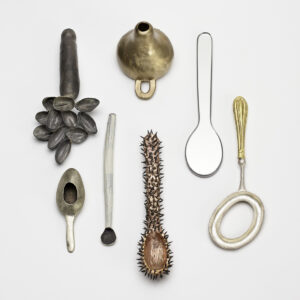
“Creatura” Photo by: Geschoepf_bb
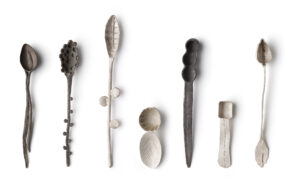
“Capriccio” Photo by: ©Dietlind Wolf
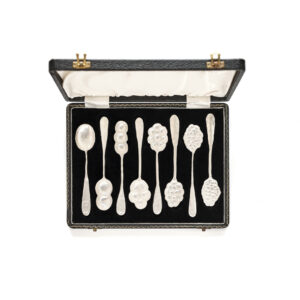
“Creatura” Photo by ©Federico Cavicchioli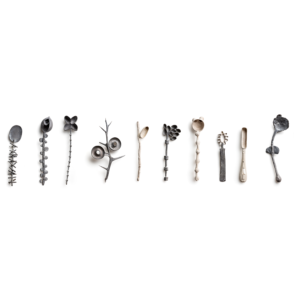
Transcript:
A spoon is one of the most basic objects we have: a line and a circle, designed for everyday use. In this simplicity, jewelry artist Gabi Veit saw a world of possibilities. She joined the Jewelry Journey Podcast to talk about how she started making spoons; why no two of her spoons are alike, even in a set; and why she is living proof that it’s never too late to study jewelry and design. Read the episode transcript here.
Sharon: Hello, everyone. Welcome to the Jewelry Journey Podcast. This is the first part of a two-part episode. Please make sure you subscribe so you can hear part two as soon as it’s released later this week.
Gabi Veit’s work is definitely different than any other you will encounter. She makes jewelry, yes, but for the past few years, she has been very taken with spoons. It’s for a variety of reasons that I will let her tell you about. She grew up in an area which I would call rough, in that the landscape is rough. It is filled with jagged edges, which I think you will see in her jewelry and spoons. Her work also calls on the organic with branches and leaves incorporated in her work. Gabi also has an unusual perspective on the world. She’s the first person to show me a PowerPoint without having a PowerPoint, which is very interesting and creative. Gabi, welcome to the podcast.
Gabi: Thank you very much for having me.
Sharon: I’m so glad you’re here. Gabi is talking to us from Switzerland, right?
Gabi: Yeah.
Sharon: I’m not familiar with the Dolomites. You were born there and you return on a regular basis. Can you tell me about them and how they influenced your jewelry?
Gabi: Yes, I’m sitting in Switzerland now, but my home base—I was born in Italy, in the Dolomites. I grew up in the outskirts of Bolzano, which is a city with 100,000 inhabitants. The mountains surround the city completely. If you wanted to, you could take three different cable cars to go up to the mountains. I saw mountains every day, always, and we went hiking every weekend. Somehow the mountains for me, the Dolomites, are my home. They symbolize vastness and mightiness. They are powerful and dangerous somehow, but they are also cozy for me. I am familiar with these mountains.
Sharon: Did you have to take cable cars most places you went, let’s say to school or the grocery store?
Gabi: No, the city is down at 250 meters. My city is very hot in the summer, so to escape this heat, you take a cable car and go up 1,000 meters in 12 minutes. Then you are in a nice, warm but not hot area with forest and with animals. The city is like a city, but it’s surrounded by mountains, and these mountains are very near. You can’t not see them, so I am used to orienting myself by looking at the mountains. I know one is in the east; the other is in the north. I’m completely lost when I don’t have mountains around.
Sharon: Can you tell us what influenced your development of spoons? It’s so unusual.
Gabi: Not really. The spoon thing started with—I have two stories. One is that I like to eat and I like to cook, so you need a spoon at least. You need more than one spoon to eat and cook. The other story is that I was in South America. After this trip, I showed a friend my treasures that I brought with me, and she said, “Oh, you are collecting spoons now.” I denied it, but she replied, “But look, there are seven spoons, and seven spoons is a collection.” So, I started to be interested in the spoon as an object, and I started to collect the spoons. Now I have more than 800 pieces.
I started as a collector, not as a maker. I was looking everywhere for spoons: at the market, at the flea market. My collection of spoons is out of wood and metal and plastics and glass and bone and horns. It’s so interesting to see how spoons are used. They have holes when you need to take olives out of the salamoia. They are big or small. It depends on the purpose. That was my entrance into the spoon world.
Sharon: You said that it’s very simple. It’s an elementary shape. What makes your spoons so unusual? What’s different about your spoons?
Gabi: I think when I started to do spoons, I was not aware that my spoons were special. I was driven first to understand how I can do spoons. Normally, when I don’t know where or how to start, I start with a restriction. As I like to eat, as I told you, and as I also like to observe people, I noticed that people have different behaviors when they eat. Someone eats very fast; the other looks more at the plate of his neighbor and not at his plate. I was thinking that maybe I should start doing spoons for people that have strange behaviors.
As I grew up in an area where Catholicism was very strong, for me, it was simple to think about the seven deadly sins, because they concentrate all behaviors in seven ways. So, I started to explore these seven sins. I was driven by finding a solution for a spoon which doesn’t help you eat well somehow. I think when someone wants it all and wants it all now, maybe you don’t eat very well; you don’t have the pleasure to eat. I did this research for one year. I did a lot of forms which were not completely perfect for this aim, but they were beautiful. That was the starting point to get a lot of different forms.
For sure, there is a second very important thing for me. That’s nature. So, on the one side is the behavior of people, and on the other side there is nature, which I also observe a lot. As I grew up in a plant nursery, I am very familiar with growing and with how a plant finds its way to get its fruits somehow. Maybe I’ve been observing plants since I was a child.
Sharon: But there are spoons that have leaves; they have twigs; they have all kinds of natural things.
Gabi: Yeah, they have. It’s all looking. I can also explain, as you said before, the spoon is a very simple tool. It’s made of one line and one circle. The circle is the bowl and the line is the handle, but nobody tells me that a circle has to be round or a line has to be straight. When I started to think about this, I was able to make a lot of variation. This is also a way to start from a very simple form. It’s easier to find a lot of variations.
Sharon: Have you made a spoon with a square or a different kind of bowl?
Gabi: Yeah.
Sharon: Did you develop these theories from the beginning of making spoons, or did they come to you as you were developing spoons?
Gabi: Both. Somehow by observing a spoon, observing how I take it in my hand and how I put it in my mouth, every day I do research on the spoon. There are theories I read and there are experiences I made. That’s a long process because I started collecting in 2001 and started making in 2006. So, there is a long experience in dealing with this tool.
Sharon: I read somewhere that you incorporate stones in everything. Is that true?
Gabi: Not really. If you mean a precious stone, I don’t use stones. I don’t use precious stones. When I go for a walk, I always pick up stones. I’m happy to see a nice stone, but maybe in my jewelry, I make my own stones.
Sharon: In your necklaces and your rings, you make your own stones. What do you mean?
Gabi: I normally work with wax. This is my main material. When I work with wax, I can form it in different ways. I can cut; I can carve it. Somehow, I carve my stones. I cut my stones, but afterwards they are cast in metal. There are only two stones I use in my jewelry. One is the garnet from my region, which I incorporate in my jewelry. For two or three years I have used rough diamonds for my jewelry, not for my spoons. My spoons are always without stones, but the jewelry has these two stones sometimes.
Sharon: The garnets from the Dolomite region, are they red? Are they green?
Gabi: They are red.
Sharon: I didn’t see any stones in any of your work that you showed.
Gabi: I did a collection. The name is Rose Garden. In my hometown, you look at the mountain of the Dolomites, the name of which is Rose Garden. When the sun goes down in the evening, it becomes pink. There is an old legend that a king lived there in this rose garden, and that he kidnapped a princess because he was in love with her. He wanted to have her in his palace, but she didn’t want to, so he kidnapped her. Her brother and other knights found her only because they knew he had a rose garden. The rose garden somehow gave them the direction and they were able to liberate her. The king was so mad about his rose garden that he said, “You will never bloom again, neither by day nor by night,” but he forgot the morning and the evening. So, these mountain blooms glow really pinkish in the evening. It’s beautiful. Somehow the garnets I found in my region in South Tyrol, they also have this red shine. So, I called this collection Rose Garden.
Sharon: If you pick up a regular stone, a rock stone, do you come home and throw it in a drawer and say, “Maybe I’ll use it someday”? Or do you have an idea?
Gabi: Not yet. There are some collections based on the form of a stone, maybe. You can see that. But in this moment, I’m not so into these stones, I think. But it’s also true that next year on, I want to do a new collection, and I have no idea where it will go. So, maybe our talk brings me to the stones. I don’t know.
Sharon: Can you make your own stones? Do you ever make a stone out of wax?
Gabi: Yeah. There are different possibilities to make stones.
Sharon: What do people use your spoons for?
Gabi: My spoons are not spoons for the mouth. They are spoons to take sugar from a bowl and to put it in your cappuccino, your tea. My spoons are used for seeds, for pepper, for chili, for all these things you take from one bowl to your plate or to your bowl. I have one client, one collector, who has a different spoon for every use. He doesn’t buy the spoon he likes. When he comes to my exhibition, I notice quickly which spoon he likes most, but only until the moment he knows for which purpose he can use it, he won’t buy it. He always finds a purpose, and that’s very good for him.
Sharon: Do you know because he’s happier or he smiles? How do you know he found the one he likes?
Gabi: It’s very interesting. He’s very silent. He looks and watches for five minutes, 10 minutes, and then he takes one spoon and another. I notice when he finds one or when he falls in love somehow. It’s really nice to observe that.
Sharon: Where do you share your spoons? At your workspace, or do you take them on the road?
Gabi: I take them on the road. Normally, I create exhibitions in museums. There are some museums in Germany, in Leipzig and in Hamburg, where there are fairs in the museum, very nicely created. There I show my work.
Sharon: That’s interesting.
Sharon: We will have photos posted on the website. Please head to TheJewelryJourney.com to check them out.

